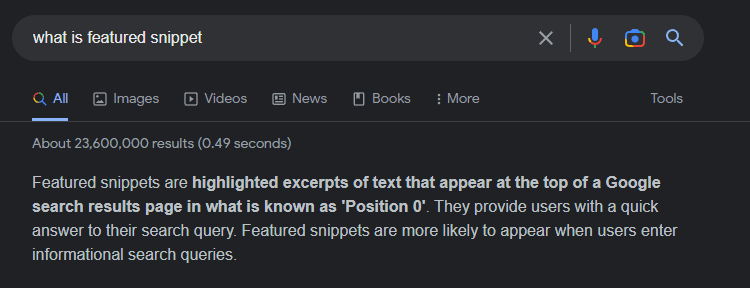Did you know that Google’s featured Snippets are shown in 25% of searches at the top of the page?
These are mainly the short answers that appear above all search results. They help people find quick and clear information with ease.
To portray your website, your content must be well organised and answer all general questions.
Using small sentences, simple language, and bullet points can help you a lot. It also helps you to use titles and structure your content so that Google can easily understand it.
Scroll down and find out how you can customise your website to a snippet. In the end, you will also be able to know the common mistakes that you need to avoid.
Let’s dive in!
Understanding Featured Snippets

There are short answers that appear at the top of Google search results. They give short and direct information without needing to click on a website. These answers come directly from webpages that are clear, helpful, and well-structured.
Below are the four types that are used for featured snippets:
- Paragraph (most common): These are short blocks of text. They deliver answers to questions like “What is…” or “Why does…” clearly in a few sentences.
- Bulleted/numbered lists: These are displayed in bullet points or numbered lists. They are used for instructions or lists, like telling features of the product or strategies.
- Tables: These show data in rows and columns. They help display comparisons, like prices, schedules, or features.
- Video snippets: These come from videos that directly answer the search query. The part of the video that’s most helpful is highlighted.
Google chooses snippets based on three important things:
- Relevance to search intent: The content must match what the user is searching for. It should answer the question directly.
- Content clarity and structure: The content must be easy to read. Short sentences, headings, and proper formatting help Google understand it better.
- Source authority and trustworthiness: The source must be reliable. Websites with accurate information, good grammar, and a clear focus are more likely to be chosen.
Keyword Research for Snippet Opportunities
Target Question-Based Keywords: Target question-based keywords (e.g., “How do I tie my shoes?”) using tools like AnswerThePublic or SEMrush. Long-tail questions align perfectly with snippet opportunities. The SEO agency will identify high-intent keywords and content gaps to maximise your snippet potential.
Optimise Content Structure for Snippets
To rank your website content in featured snippets:
- Use Clear Headers: Begin to use headers like H2 or H3 to break your content into sections. These headers should be written as questions, such as “How to Optimise CSS for Mobile?” This tells Google exactly what the section is about.
- Provide Concise Answers: Give a short and direct answer right after each header. Answer the question within the first 40 to 60 words. Make sure that you keep your content simple, and answers must be to the point so that it’s easy for Google to understand.
- Leverage Lists and Tables: When sharing steps or tips, use bullet points. They make your instructions easier to follow. For example, a list of simple actions, like “Open the app,” “Go to settings,” and “Click save,” helps readers and Google read your content quickly.

When you’re showing a difference or comparison, try to use a table. This lets you manage information in rows and columns. This makes it easier for users to understand your content, and even in a particular snippet, for users and even for Google.
On-Page SEO Enhancements
To keep your website from showing up in featured snippets, make a few improvements to each page. It helps Google to understand your site and trust your content.
- Optimise metadata: Every page has a meta title and a meta description. These are what people see in Google search. Add your main question-based keywords here, like “How does solar energy work?” This tells Google that your page delivers a clear answer. Keep it short, simple, and helpful to get more clicks.
- Schema Markup: A schema is a special bit of code added to your page. It helps Google know what type of content you have. Adding an FAQ schema or a How-to schema can make your content more structured. This improves the chance of being shown in results like featured snippets.
- Internal Linking: Connect your pages by linking to related topics on your site. This helps visitors explore more and stay longer. It also shows Google that your website covers the topic well. The more useful content you link together, the more authority your site builds in that area.
- Page Speed & Mobile Optimisation: Slow page load time runs away users. Use Pagespeed Insights to analyse and improve the speed of your site. In addition, make sure that your site works well on each device. Google preference pages that load fast and look great on mobile.
Monitor and Refine
After creating the good content, you need to see how it’s working. This helps you to keep your site in good condition for featured snippets.
- Track Performance: Use Google Search Console to see how your pages perform in search results. Look for “Impressions” and see if your content appears in “Position Zero”. This helps you to tell whether your content is in the featured snippet box. Also, check how many people are clicking on your link. This shows if your snippet is helpful and getting attention.
- Analyse Competitors: Look at what other top websites are doing. Use tools like Ahrefs to study their content. Check what questions they are answering and what kind of format they use- paragraphs, lists, or tables. Learn from their strength and see that you can do even better.
- Update Content Regularly: Don’t let your content get outdated. Regularly check your pages and make sure you are updating them often. Update numbers, facts, or steps if things change. Adding new helpful tips can also boost your chances of staying in the snippet.

Common Mistakes to Avoid
- Keyword stuffing instead of natural answers: Some try to use the same word again and again, like “best shoes, best shoes, best shoes.” This is called keyword stuffing. This writing sounds strange and difficult to read. Google prefers natural answers that are clear, helpful, and easy to understand. Use your main keywords, but do not overdo it.
- Overlooking mobile users: Today, most people use their phones to search. If your website looks dirty or loads slowly on a phone, users can leave quickly. Google sees this and can rank your site lower. Always make sure that your site is sharp and works well on mobile devices.
- Failing to update underperforming content: If your page has old facts, broken links, or outdated tips, Google may skip it. Update your content regularly. Add new stats, improve answers, and check all links to keep your content fresh and accurate.
Case Studies and Examples
A website once made a simple table to compare iPhone and Samsung phones. The table showed features like battery life, camera quality, and price side by side. It was clean, easy to read, and gave clear answers. Because it was very helpful, Google chose it as a special snippet and showed it at the top of the search page. This suggests that using a clear comparison table can help your content stand out and win a top position in search results!
Conclusion

Ranking your website at the top of Google is just like winning a prize. For this, you need to answer the questions to the point and in a useful manner. Use short words, lists, and pictures like tables. Make sure your site is sharp and works well on every device. Keep your information fresh and easy to read. If Google likes your page, it can show your answer in a painted snippet box on top. This means that more people can see your site. Just be helpful, stay clear, and keep learning from others. That’s how you can shine on Google!






